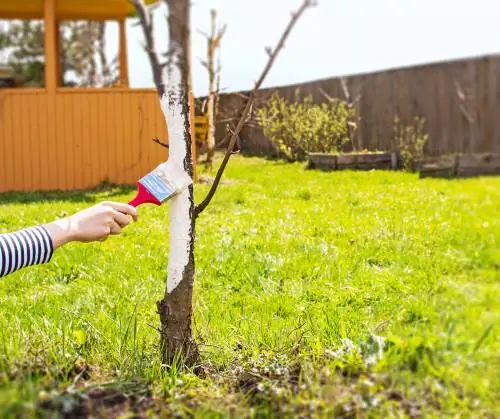- Author admin [email protected].
- Public 2023-12-16 16:46.
- Last modified 2025-01-23 11:20.
So that the hydrangea does not freeze back too much in frosty temperatures, the relatively winter-hardy plant needs some winter protection, especially in harsh regions. If you follow our care measures for the cold season, your hydrangeas will thank you next spring with strong growth and lots of magnificent flowers.

How do you protect hydrangeas from frost?
To protect hydrangeas from frost, mulch the soil around the plant with bark mulch or leaves and pile up the root collar with garden soil or compost. Protect shoots and buds with fleece or wire mesh and brushwood, but avoid airtight materials.
Suitable hydrangea species for locations at risk of frost
Not all hydrangeas are completely hardy and survive well below freezing temperatures. In areas where there is a risk of permanent frost, you should only plant one of the following species.
The following are well tolerated by frost:
- Farmer Hydrangeas
- Garden hydrangeas
- Japanese hydrangeas
- Forest hydrangeas
- Climbing hydrangeas
- Plate hydrangeas
Overwintering frost-resistant varieties properly
These frost-resistant hydrangeas also need suitable winter protection so that they do not freeze back too much in low temperatures. There are a few points you should consider in advance when it comes to care:
- Fertilize the hydrangea for the last time in summer so that the fresh shoots can mature by autumn.
- Do not cut back hydrangeas in autumn. Only remove the spent flowers and dead wood.
- The plants need a relatively large amount of water. However, waterlogging when watering should be avoided at all costs. Root damage weakens the hydrangea, making the plant more susceptible to frost damage.
Appropriate winter protection
Mulch the subsoil around the hydrangea with a layer of bark mulch or leaves about ten centimeters thick. This layer of mulch acts like a warming blanket and protects the hydrangea from frost. In rough locations, it is recommended to pile up the root collar ten to twenty centimeters high with garden soil or compost.
To protect the shoots and buds from cold damage, use special fleeces (€32.00 on Amazon) or alternatively a wire mesh that you cover with brushwood. It is important that the plant can breathe under this winter protection. Plastic films and airtight materials are unsuitable as condensation forms underneath them. This promotes rot and can cause massive damage to the plant.
Tips & Tricks
Just a look at the plant label tells you whether the hydrangea can tolerate frost. You should not overwinter varieties that prefer sun outdoors. Hydrangea species that say they thrive in the shade are usually also hardy.






